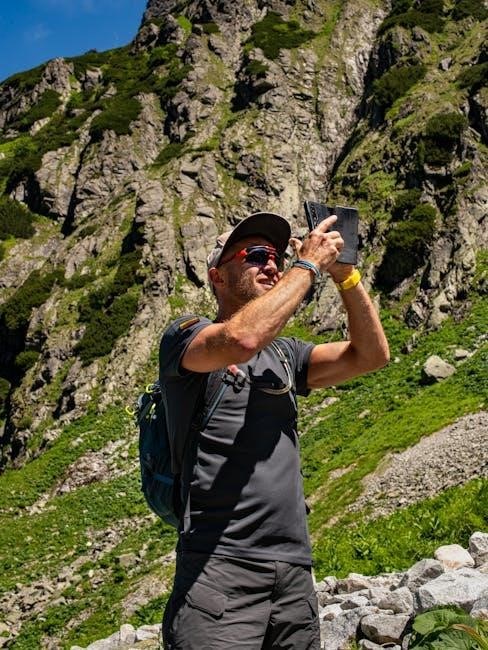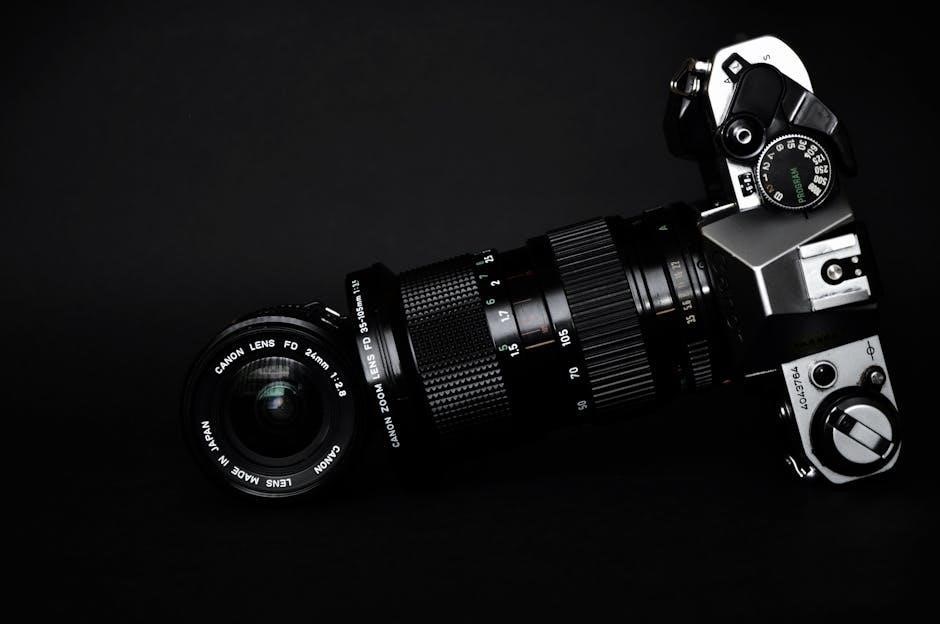
moultrie trail camera manual
Moultrie trail cameras are renowned for their versatility, reliability, and innovative technology in wildlife monitoring and hunting. Designed to capture high-quality images, these cameras offer advanced features like night vision, motion sensors, and durable construction, making them essential tools for outdoor enthusiasts and professionals alike.
1.1 Overview of Moultrie Trail Cameras
Moultrie trail cameras are highly regarded for their reliability and innovative technology, designed to meet the needs of hunters, wildlife enthusiasts, and outdoor professionals. These cameras are equipped with features such as night vision, motion sensors, and high-quality image capture, making them excellent tools for monitoring wildlife. Available in various models, including the A-Series, M-Series, and GAMESPY D55IR, Moultrie cameras cater to different preferences and requirements. They offer durable construction, user-friendly interfaces, and compatibility with accessories like solar power and mounting devices. The cameras are supported by comprehensive manuals, providing detailed setup instructions, troubleshooting tips, and configuration guides. Whether for hunting, property surveillance, or wildlife observation, Moultrie trail cameras deliver exceptional performance and value, ensuring users capture the moments that matter. Their versatility and robust design make them a trusted choice in the field of trail camera technology.
1.2 Importance of the Manual
The Moultrie trail camera manual is an essential resource for users to maximize their device’s potential and ensure optimal performance. It provides detailed instructions for setup, configuration, and troubleshooting, helping users navigate features like night vision, motion sensors, and image quality settings. The manual also covers safety guidelines, warranty information, and FCC regulations, ensuring compliance and preventing potential damage. Additionally, it offers insights into accessories, battery management, and storage tips, enhancing the camera’s longevity and efficiency. By following the manual, users can avoid common issues and make the most of their camera’s capabilities. Whether you’re a novice or an experienced user, the manual serves as a comprehensive guide to unlocking your Moultrie trail camera’s full functionality and achieving the best results in wildlife monitoring or hunting scenarios. Regularly consulting the manual ensures a seamless and effective user experience.

Key Features of Moultrie Trail Cameras
Moultrie trail cameras feature advanced night vision, motion sensors, high-resolution imaging, ample storage, and long battery life, ensuring reliable performance in various outdoor conditions with excellent connectivity options.
2.1 Camera Models and Specifications
Moultrie offers a diverse range of trail camera models, each designed to meet specific needs. The A-Series is known for its user-friendly design, featuring models like the A20, A30, and A40, which offer varying resolutions and PIR sensitivity. The M-Series, including the M-999i and M-50, provides higher resolution and improved low-light performance. The GAMESPY D55IR model is a budget-friendly option with infrared technology for night vision. The EDGE series, including the EDGE and EDGE 2 PRO, boasts advanced features like cellular connectivity and HD video recording. Each model varies in megapixel resolution, trigger speed, and storage capacity, ensuring there’s a camera for every outdoor enthusiast’s requirements. Detailed specifications for each model are outlined in their respective manuals, allowing users to choose the best fit for their needs.
2.2 Night Vision and Motion Sensors
Moultrie trail cameras are equipped with advanced night vision capabilities, utilizing infrared (IR) LEDs to capture images in low-light conditions without startling wildlife. The IR flash is invisible to animals, ensuring discreet monitoring. Models like the GAMESPY D55IR feature a high-power 850nm LED for superior night vision. Motion sensors, or PIR (Passive Infrared) sensors, detect heat and movement, triggering the camera to capture images or videos. The sensitivity of these sensors can be adjusted, with higher settings covering larger areas but potentially causing false triggers, while lower settings reduce unwanted activations. This feature is particularly useful in various environments, from open fields to dense forests. The combination of night vision and motion sensors ensures that Moultrie cameras deliver reliable performance for wildlife monitoring and surveillance. Proper configuration of these settings is detailed in the manual for optimal results.
2.3 Image Quality and Storage
Moultrie trail cameras deliver exceptional image quality with high-resolution sensors, capturing detailed photos and videos of wildlife. The cameras support various settings, including megapixel resolution adjustments, ensuring crisp images even in challenging lighting conditions. The storage capacity is expandable with SD cards, supporting up to 32GB, allowing for extensive photo and video storage. The manual provides guidance on optimizing image settings and managing storage efficiently. Additionally, the cameras often feature internal memory for temporary storage before data transfer. Proper setup ensures that images are stored securely, making it easy to review and manage wildlife activity. The combination of high-quality imaging and ample storage options makes Moultrie cameras a reliable choice for outdoor enthusiasts.

Popular Moultrie Trail Camera Models
Moultrie offers a range of models, including the A-Series, M-Series, and GAMESPY D55IR, each designed for reliability, image quality, and durability in various wildlife monitoring scenarios.
3.1 A-Series Trail Cameras
The A-Series by Moultrie is a line of trail cameras known for their reliability and durability, making them ideal for hunting and wildlife monitoring. These cameras are designed with user-friendly features, including long battery life and high-quality image capture. The A-Series models, such as the MCG-12688, are popular for their affordability and performance in various outdoor conditions. They offer excellent motion detection and night vision capabilities, ensuring clear images even in low-light environments. The cameras are also compatible with SD cards for storage and can be easily mounted in the field. With their robust construction and advanced features, the A-Series trail cameras are a favorite among hunters and nature enthusiasts. Additionally, they support accessories like solar power options, enhancing their functionality and longevity in remote locations.
3.2 M-Series Trail Cameras
The M-Series by Moultrie is a line of trail cameras designed for performance and reliability, catering to hunters and wildlife enthusiasts. Models like the M-999i and M-800 offer impressive features such as high-resolution image capture, motion detection, and infrared night vision. These cameras are known for their durability and ability to perform in challenging outdoor conditions. The M-Series also boasts long battery life, making them ideal for extended use in the field. With features like adjustable PIR sensitivity and compatibility with SD cards for storage, these cameras provide users with flexibility and convenience. Their compact design and ease of setup make them a popular choice for both novice and experienced users. The M-Series is a testament to Moultrie’s commitment to delivering high-quality, innovative trail camera solutions.
3.3 GAMESPY D55IR Model
The Moultrie GAMESPY D55IR is a high-performance trail camera designed for wildlife monitoring and hunting applications. Equipped with a 4.0 megapixel sensor and infrared night vision, it captures crisp images even in low-light conditions. This model is part of Moultrie’s Game Management System, allowing users to track wildlife patterns effectively. The camera features motion detection, a fast trigger speed, and compatibility with SD cards for storage. Its durable construction ensures reliability in harsh outdoor environments. The GAMESPY D55IR is user-friendly, with an intuitive interface for setup and configuration. While it may not have all the advanced features of newer models, it remains a solid choice for those seeking a dependable and affordable trail camera solution; Its simplicity and effectiveness make it a favorite among outdoor enthusiasts.

Setting Up Your Moultrie Trail Camera
Setting up your Moultrie trail camera is straightforward. Begin by installing eight AA batteries and inserting an SD card for storage. Power on the camera and navigate through the LCD menu to set date, time, and other settings. Mount the camera at an optimal height using the included strap or a tree mount. For PC connection, use a micro-B USB cable to transfer photos or update firmware. Adjust PIR sensitivity based on your environment to minimize false triggers. Finally, explore the Moultrie Mobile app for remote monitoring and enhanced functionality. Proper setup ensures your camera captures wildlife effectively and efficiently.
4.1 Initial Setup and Installation
The initial setup of your Moultrie trail camera is crucial for optimal performance. Start by carefully unpacking the camera and ensuring all components are included. Insert eight AA alkaline or lithium batteries into the battery compartment, following the polarity indicators to avoid damage. Next, install an SD card (up to 32GB) to store images and videos. Power on the camera by pressing and holding the On/Off button until the LCD display lights up. Use the navigation buttons to set the date, time, and other basic settings. For proper image capture, ensure the camera is securely mounted to a tree or post using the included strap or a compatible mounting bracket. Finally, test the camera by triggering the motion sensor to confirm it is functioning correctly. Proper installation ensures your camera is ready to capture wildlife effectively.
4.2 Mounting the Camera
Properly mounting your Moultrie trail camera ensures optimal performance and durability. Begin by selecting a location with a clear view of the area you wish to monitor, such as a game trail or food source. Use the included adjustable strap to secure the camera to a tree, tightening it firmly to prevent movement. For added stability, consider using a mounting bracket or lockbox, especially in high-traffic areas. Ensure the camera is level and positioned at an ideal height to capture images effectively. Avoid pointing the camera directly at the sun to minimize glare. If using a solar power option, ensure it is oriented toward direct sunlight. Finally, check the camera’s placement periodically to ensure it remains secure and functional. Proper mounting is essential for capturing high-quality images and extending the camera’s lifespan. Always follow safety guidelines when installing.
4.3 Connecting to a PC
Connecting your Moultrie trail camera to a PC allows you to transfer images, update firmware, and manage settings. To begin, ensure the camera is turned on and in “Setup” mode by sliding the mode switch. Use a micro-B to USB cable (not included) to connect the camera to your computer. The USB port is typically located on the side or bottom of the camera. Once connected, your PC should recognize the device, enabling you to access stored photos and videos. If the camera is not detected, ensure the USB cable is functioning properly and the camera is in the correct mode. For firmware updates, follow the instructions provided in the manual or on the Moultrie website. Regularly transferring data to your PC helps manage storage and ensures your camera remains operational. Always follow the manual’s guidelines for a seamless connection.

Configuring Your Trail Camera
Configuring your Moultrie trail camera involves adjusting settings like PIR sensitivity, image quality, and motion detection to optimize performance for your specific needs. Use the manual or app for guidance.
5.1 Basic Settings and Configuration
Configuring your Moultrie trail camera starts with understanding its basic settings. Begin by setting the date, time, and camera name to organize your data effectively. Adjust the PIR (Passive Infrared) sensitivity to customize motion detection, with higher settings ideal for open areas and lower settings for wooded environments. Set the camera to capture photos, videos, or both, depending on your needs. Choose image quality settings, such as resolution and compression, to balance file size and clarity. Enable or disable features like night vision, timestamps, and camera alerts. Use the Moultrie Mobile app to remotely configure settings, ensuring seamless monitoring. Properly format the SD card before use and ensure batteries are fully charged for optimal performance. Refer to the manual for detailed guidance on each setting to maximize your camera’s functionality and efficiency. Regularly review and update settings to adapt to changing conditions or objectives.
5.2 Adjusting PIR Sensitivity
Adjusting the PIR (Passive Infrared) sensitivity on your Moultrie trail camera is crucial for optimizing motion detection. The PIR sensor detects heat and movement, and its sensitivity can be set to high, medium, or low. High sensitivity is ideal for large open areas, detecting motion over longer distances but may increase false triggers. Low sensitivity is better suited for closer ranges and wooded environments, reducing unwanted activations. To adjust, navigate to the PIR settings in the camera menu, choose your preferred level, and save the changes. Ensure the camera is positioned to avoid obstructions or heat sources that could interfere with detection. Regularly test and refine the sensitivity based on your environment and desired results. Proper calibration ensures efficient and accurate wildlife monitoring, enhancing your overall experience with the camera.
5.3 Using the Moultrie Mobile App
The Moultrie Mobile app is a powerful tool designed to enhance your trail camera experience. It allows seamless connectivity to your Moultrie cellular trail camera, enabling remote access to images, videos, and camera settings. To get started, download the app from the Google Play Store or Apple App Store and create an account. Once installed, follow the in-app instructions to pair your camera with the app. This typically involves entering the camera’s serial number and confirming the connection. The app provides features like real-time image and video delivery, customizable notifications, and the ability to adjust camera settings remotely. You can also manage multiple cameras from a single interface, making it ideal for large surveillance areas. The app’s intuitive design ensures easy navigation, allowing you to monitor wildlife, optimize camera performance, and receive updates on the go. Regularly check for app updates to ensure you have the latest features and improvements.

Troubleshooting Common Issues
Address common problems like sensor sensitivity, connectivity issues, or battery drain. Refer to the manual for reset instructions, firmware updates, and maintenance tips to ensure optimal camera performance.
6.1 Common Problems and Solutions
Users often encounter issues like poor image quality, motion detection failures, or battery drain. For blurry photos, ensure the camera is level and free from obstructions. If motion detection isn’t triggering, check sensor sensitivity settings. Low battery life can be resolved by using high-quality alkaline or lithium batteries. Connectivity issues with the Moultrie Mobile app may require resetting the camera or updating firmware. Always refer to the manual for detailed troubleshooting steps. Regularly cleaning the lens and ensuring proper SD card installation can prevent common issues. For persistent problems, contact Moultrie support for assistance. Proper maintenance and configuration are key to optimal performance.
6.2 Resetting the Camera
Resetting your Moultrie trail camera can resolve various issues like persistent glitches or incorrect settings. To reset, press and hold the “On/Off” button for 10-15 seconds until the camera powers off. Release the button and wait a few seconds before turning it back on. This process restores the camera to its factory settings, erasing all custom configurations. Note that resetting will clear all stored settings, so you’ll need to reconfigure the camera afterward. If issues persist after a reset, consider updating the firmware or consulting the manual for further troubleshooting steps. Resetting is a useful step before setting up the camera for a new location or transferring ownership. Always ensure the camera is powered on and batteries are fresh before attempting a reset.

6.3 Updating Firmware
Updating the firmware of your Moultrie trail camera ensures optimal performance, fixes bugs, and adds new features. To update, visit the Moultrie website and download the latest firmware version for your specific model. Transfer the firmware file to an SD card using a computer. Insert the SD card into the camera, power it on, and navigate to the setup menu. Select the “Firmware Update” option and follow the on-screen instructions. The camera will restart during the process, which may take a few minutes. Do not turn off the camera or remove the SD card during the update, as this could cause malfunctions. Once complete, the camera will be updated and ready for use. Always use a fully charged battery or external power source when updating firmware to avoid interruptions.

Maintenance and Care
Regular maintenance ensures your Moultrie trail camera functions optimally. Clean the lens and housing with a soft cloth to prevent debris buildup. Store the camera in a dry, cool place when not in use. Always check battery levels and replace weak batteries promptly to avoid damage. Use only compatible SD cards and format them regularly for proper storage. For extended storage, remove batteries to prevent corrosion. Proper care extends the camera’s lifespan and ensures reliable performance in the field.
7.1 Cleaning and Regular Maintenance
Regular cleaning and maintenance are essential to ensure your Moultrie trail camera operates effectively. Use a soft, dry cloth to wipe the camera’s exterior and lens, removing dirt or debris that may obstruct vision. Avoid harsh chemicals or abrasive materials that could damage the casing or lens. For stubborn dirt, slightly dampen the cloth with water, but ensure no moisture enters the camera. Inspect the camera’s cables and connections for damage or wear. If using external power sources, check the solar panel or battery compartment for cleanliness. Store the camera in a dry, cool place when not in use to prevent moisture buildup. Regular maintenance ensures optimal performance, clear image quality, and prevents false triggers caused by debris. Always refer to the manual for specific cleaning instructions tailored to your model.
7.2 Battery Management
Proper battery management is crucial for ensuring your Moultrie trail camera operates reliably. Use high-quality alkaline or lithium batteries, as other types may damage the camera. For optimal performance, install batteries with matching charge levels and avoid mixing old and new ones. If using a solar power option, ensure the panel is clean and correctly positioned to maximize energy absorption. Regularly check battery levels, especially during extreme weather conditions, as cold temperatures can reduce battery life. Replace batteries promptly when low to prevent shutdowns. For extended use, consider external power sources like the Moultrie 12V Dual Solar Battery Box, compatible with select models. Always remove batteries during long-term storage to avoid corrosion. Refer to your camera’s manual for specific battery recommendations tailored to your model.
7.3 Storing the Camera
Proper storage of your Moultrie trail camera ensures longevity and optimal performance. Clean the camera thoroughly before storage, paying attention to the lens and exterior surfaces, using a soft cloth to avoid scratches. Store the camera in a cool, dry place, away from direct sunlight and moisture to prevent damage. Remove the batteries to avoid corrosion and ensure the memory card is taken out or formatted. Use a protective case or bag to safeguard the camera from dust and physical damage. If storing for an extended period, consider using silica gel packets to maintain dryness. Always refer to the manual for specific storage recommendations, as improper storage can affect the camera’s functionality. By following these steps, you can ensure your Moultrie trail camera remains in excellent condition for future use.

Accessories for Moultrie Cameras
Moultrie offers a variety of accessories to enhance functionality, including solar power options, mounting devices, and compatible memory cards. These accessories ensure optimal performance and convenience.

8.1 Compatible Accessories
Moultrie trail cameras are complemented by a range of compatible accessories designed to enhance performance and convenience. Solar power options, such as the 12V Solar Battery Box, ensure extended battery life, especially in remote locations. Mounting devices like tree mounts, tripods, and security locks provide flexibility and protection against theft. Additional storage solutions, including high-capacity SD cards and card readers, enable efficient photo and video management. These accessories are engineered to integrate seamlessly with Moultrie cameras, ensuring optimal functionality and durability. Whether for hunting, wildlife monitoring, or outdoor surveillance, Moultrie’s accessory lineup offers practical solutions to meet diverse user needs.
8.2 Solar Power Options
Moultrie trail cameras offer solar power solutions to ensure continuous operation in the field. The Moultrie 12V Solar Battery Box is a popular choice, designed to work seamlessly with 12-volt game cameras, providing reliable power even in remote locations. This accessory is ideal for long-term deployments, reducing the need for frequent battery replacements. It is not compatible with 6-volt Micro Series cameras and feeders, so users must ensure compatibility before purchase. The solar battery box is durable and weather-resistant, making it suitable for outdoor conditions. For optimal performance, it should be positioned to receive maximum sunlight. This eco-friendly option not only extends battery life but also reduces maintenance, making it a practical choice for hunters and wildlife enthusiasts. It can be used alongside a battery pack for uninterrupted power during low-light periods.
8.3 Mounting and Security Devices
Moultrie trail cameras offer a variety of mounting and security options to ensure your device remains stable and protected in the field. Tree mounts and tripods are popular choices, allowing users to position cameras at optimal heights and angles. For added security, Moultrie provides locking mechanisms and anti-theft cables to prevent unauthorized access or theft. These devices are designed to withstand harsh outdoor conditions and ensure your camera remains securely in place. Additionally, mounting accessories like adjustable brackets and straps enable easy installation on trees, fences, or other structures. These solutions not only enhance the camera’s performance but also provide peace of mind, knowing your investment is safeguarded. Durable materials and weather-resistant designs further ensure long-lasting reliability in various environments.
Moultrie trail cameras are reliable tools for wildlife monitoring, offering advanced features, ease of use, and durability. This manual provides comprehensive guidance to maximize their performance and longevity effectively.
9.1 Summary of Key Points
This manual provides a comprehensive guide to understanding and optimizing the use of Moultrie trail cameras. Key features include advanced night vision, motion sensors, and high-quality image capture. Proper setup involves initial installation, mounting, and connecting to a PC for data transfer. Configuration options allow users to adjust settings like PIR sensitivity and utilize the Moultrie Mobile app for remote monitoring. Troubleshooting common issues ensures uninterrupted performance, while regular maintenance and battery management extend the camera’s lifespan. Accessories like solar power and mounting devices enhance functionality. By following these guidelines, users can maximize their trail camera’s potential for wildlife monitoring and hunting success. Always refer to the manual for specific model details and updates to ensure optimal performance.
9.2 Final Tips for Optimal Use
To achieve the best results with your Moultrie trail camera, ensure proper placement in areas with high animal traffic. Regular maintenance, including cleaning the lens and checking battery levels, is essential for reliable performance; Adjusting PIR sensitivity according to the environment minimizes false triggers and conserves battery life. Utilize the Moultrie Mobile app to monitor activity remotely and receive real-time updates. For extended use, consider solar power options to reduce battery replacements. Always follow safety guidelines when handling the camera and accessing stored data. Familiarize yourself with local regulations regarding trail camera use. By adhering to these tips, you can enhance your hunting or wildlife monitoring experience and capture high-quality images consistently. Proper care and strategic placement will ensure your Moultrie trail camera operates effectively for years to come.